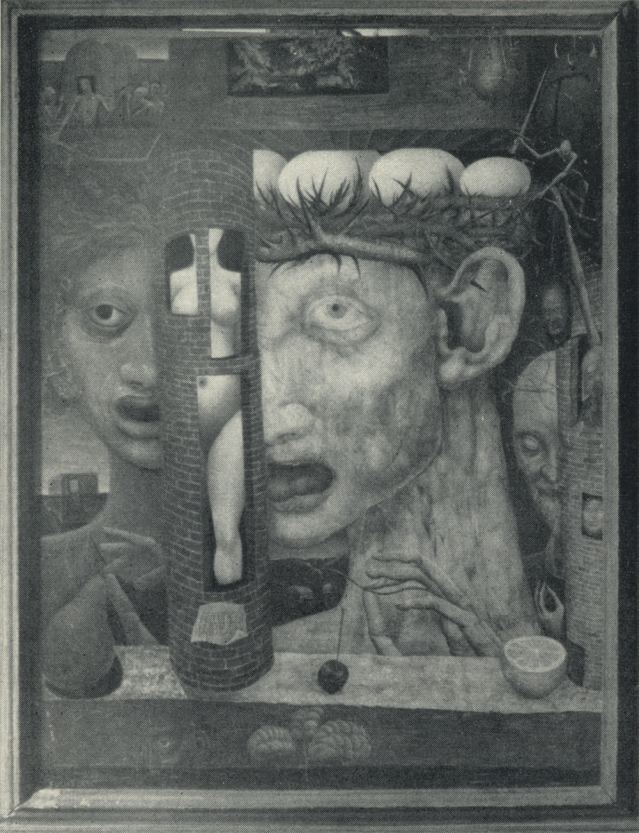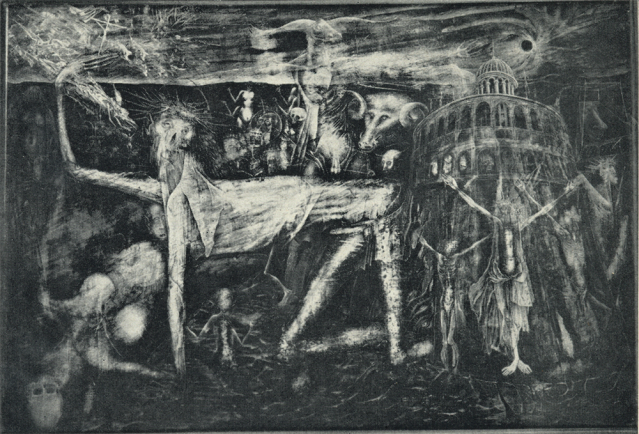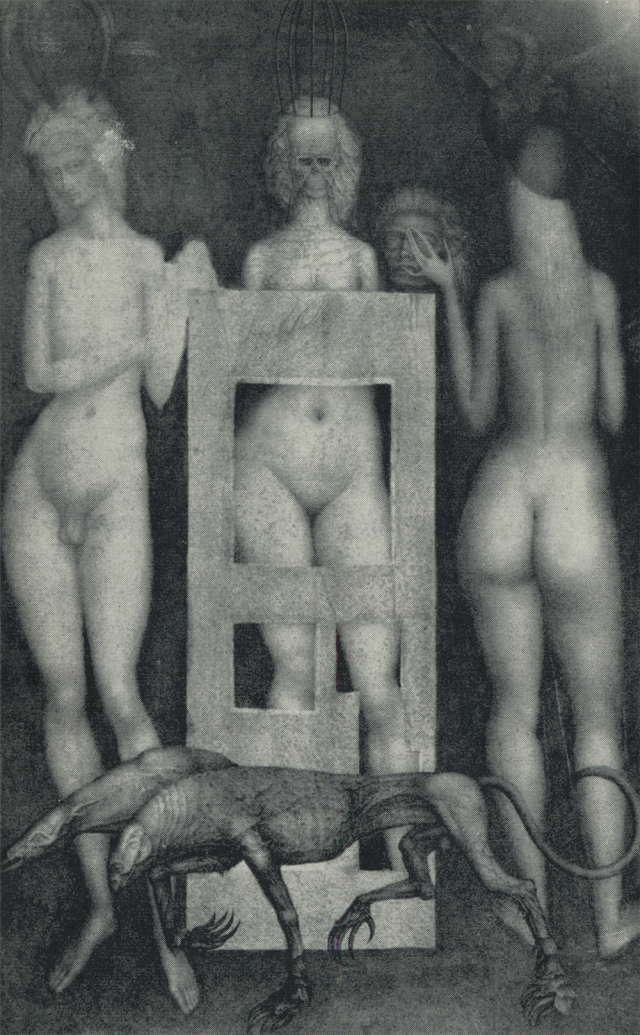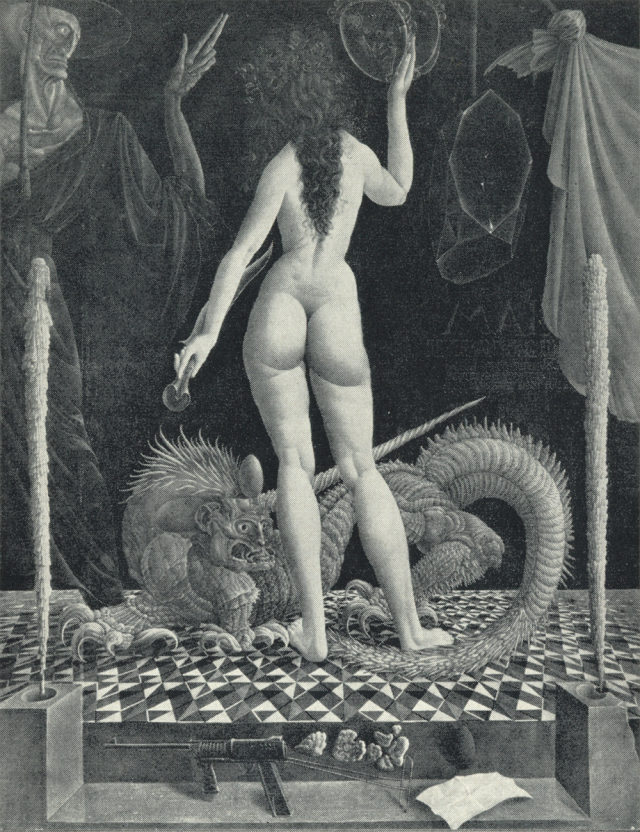Ernst Fuchs was born February 13, 1930, in Vienna. He began his artistic training at the Vienna Academy of Fine Arts under Prof. Albert Paris Gutersloh in 1945. Fuchs is the founder of the so-called Viennese School of painters of (he surrealistic and fantastic. Most of the members of this group have been students of his at one time or another to learn the old-master technique which he has developed to a high degree of perfection by painstaking study of the Netherlandish Mannerists and the Venetians. He prefers to call the movement symbolistic rather than surrealistic, since it is more similar to the English Symbolists, the Pre-Raphaelites, and the Viennese Secession. The interview (in English) took place in Fuchs' studio in Vienna.
M. What led you to become an artist. Mr. Fuchs?
F. I think the influence of my father was very important in my becoming a painter. Although I don't really consider it my true profession. I'm a singer, you know. I continued in painting because I was afraid to sing.
M. Afraid?
F. I was afraid of myself. I fell into a trance which lasted quite some time, and that happened several times so that I began to think that painting was inferior to singing.
M. In what way inferior?
F. It is not as close to prophecy, because singing is prophecy, I believe. It is a language of its own with melodies and everything; painting is a completely other dimension. But painting is something I can do, and I think that the same message is in it, too, perhaps hidden.
M. How is such a message received by an artist?
F. Before beginning to sing I had believed in inspiration like the ancient peoples did. And after these events I saw that singing was the most pure way of being inspired. I had a hard time picking up painting again, and considering painting something worthwhile doing.
M. Then an artist expresses in his work the message he receives through inspiration. How does he receive inspiration?
F. I paint something I don't know; I don't look for the image. It may come from what people call the subconscious, but that is only one name for something where we think we accumulate and store our impressions. I remember when I was a small child, maybe three years old, I had experiences of die appearance of the spirits of the dead. Yet I didn't know about that. I didn't even know that people died.
M. Could you explain what inspiration is?
F. Inspiration is being contacted by spirits. You arc always being contacted by spirits, good ones and bad ones. Artistic inspiration is just one level of this. Inspiration is an angel giving you a message. When Moses was told to build die Ark of the Covenant, he was told to build it according to the plan which God had shown him on the Mount. I would have to look it up to give the exact words. If you do something like that, by inspiration, you do it according to a pattern which is pre-existent. The artist is nothing but a medium, to a greater or lesser degree according to his gift, of wrangling with what he sees or feels.
M. Then inspiration is somehow connected with a gift which the artist has, to receive it and bring it to expression.
F. Yes, if you put three or four people in front of a tree, they will all agree that they see a tree, but they will draw it differently according to how they are gifted. The source of that information and inspiration is the experience of nature—die contact with their surroundings. It could as well be the contact with an angel.
M. What is an angel? Aren't they symbols or parables for the forces of nature?
F. No, an angel is a creature like any other creature. They can descend as messengers, and can suddenly be seen or dreamt of. What I paint is usually a reflection of these things that I see or that I dream of. Maybe there arc certain people who arc gifted to see that which for ordinary people is invisible. Other people are gifted to interpret reality, like Cezanne. Some people can open their eyes as wide as they want, but they will never see die things I paint. Even the subject matter is for them invisible. So the artist of the fantastic is to be compared more to a madman by people who cannot understand.
M. Then many people think you mad because your pictures are not within their experience?
F. Yes, yet some people know what die subject matter is without even having to be told. Last summer when I was in Israel, I showed a drawing to a twelve year old boy. He said, “Yes, it is well done; you know how to draw.” When I asked what he thought the drawing was, he answered, “I don't know the English word, but we call it Malachim (angels).” Sometimes I felt myself completely mad if I should call that an angel. But now I have more proof; I have met a few people who call the drawing an angel without being told what it is. There must be a common contact in the subconscious with some people that makes spiritual contact less subjective.
M. Have you always painted subjects of fantasy?
F. No, I went to art school and did drawings after nature, which arc completely different from my other work. You know, all the nudes and things. I never did like to draw them very much. I wasn't interested in using nature. I never use models now. Even as a child I always drew out of my imagination.
M. Have other artists in different periods done this also?
F. Yes, definitely. I was greatly impressed when I first saw Blake. In spite of certain traces of classicism which make him easy to place in history, there are things in his work which do not seem to fit anywhere. When he draws a prophet it looks as if it were seen above time.
M. Your present works are something of a new approach in subject matter. Can you explain what you are doing now?
F. In my recent works I am representing something which can look like polished stone or quartz. The fountain in Bosch's “Garden of Heavenly Delights” is similar to this. The fountain is stony and yet at die same time it is like a plant. You can eat it.
M. Do you think that Bosch represented these forms purposely?
F. No, I don't think that he had a conscious idea of what he was painting, just as I don't have a conscious idea of what I paint. It makes me think that his inspiration was on the same level. Until recently Bosch was for me fantastic animals and creatures. Perhaps I overlooked the plant forms. Bosch was much imitated in his time, but the trees and plants were not imitated. The fantastic creatures attracted more attention. I myself did not until recently see them.
M. Do you know of other examples of this?
F. I found something in the Bible which made me think of it. In Ezekiel 28 there is a description of a cherub with mention of brightness and precious stones and “Stones of fire” which probably are the stars. Perhaps I wouldn't have needed it to draw my things. Yet I am glad to sec it because it gives me proof that I am on the right way. I don't want to be a madman, or at least not to be thought of as one.
M. The surfaces in your works are stones?
F. No, these things can be stones or they can be a substance like the meat of fruits such as oranges. They are both solid and liquid.
M. But in ordinary concepts these are opposite terms.
F. “Stone” and “water” are for us only analogies. There is a story in the Lesser Hekhaloth which gives an example of the possible relationship of polished stones to water.
Ben Azai was deemed worthy mid stood at the ^ate of the sixth palace and saw the ethereal splendor of the pure marble plates. He opened his mouth and said twice, “Water! Water!” In the twinkling of an eye they decapitated him and threw eleven thousand iron bars at him. This shall be a sign for at! generations that no one should err at the gate of the sixth palace.*
Subconsciously we all have a knowledge of these relationships. I want to make a book now, and then I will compare these relationships, and try to explain it. I will call the book Architectura Caeleste. I have only started dunking about the relationships. Before I just painted. I really didn't care to know what it was. In painting it is easier to give such representations, because in writing there are certain concepts which words connote which cannot he erased in order to compare stones to water.
M. When did you begin in this direction? Your earlier works are more concerned with grotesque and fantastic creatures.
F. The first pictures that looked like this were done in Munich in 1958. In the earlier works I was following another inspiration. That was a world that corresponds to more sensual things—demons and evil spirits. I got to my present direction through my religious pictures. I did the drawings for the church-altar in Hetzendorf-Wien to get the spirit of the Holy Rosary, which I didn't really know much about. I got many images which were completely new forms. I was converted to Catholicism in America in 1956, and started doing some religious pictures—Crucifixions, etc.
M. Abstract artists pretend to express the confused and despairing state of modern man by the complete dissolution of recognizable forms, with only color remaining. Is your direction toward grotesque distortion and fantastic symbolism a sort of criticism?
F. No, in my earlier works I was not trying to criticize anything. There was to be a trial because I had supposedly dishonored the Church in my drawing Crucifixion (1949). But I did not want to criticize anything. I did not have the intention of sacrilege because I have always had the greatest respect for Jesus Christ, even in my pre-confessional days. Because I drew a crucified man, it did not mean that it was Christ—it just turned out that way. I think that I merely made a commentary on the concentration camps. A lot of my relatives died in concentration camps and the thought that you were completely helpless against a gang of killers made a great impression on me.
M. How do you begin to formulate a picture?
F. I don't think about my work, especially while I am working. After I finish, sometimes I try to find out what ! did. I just start, without a single line of preparation. I don't know if I will keep on painting the way I do now. I did not think eight years ago that I would paint such things. Sometimes I am asked to do things this way or that, but I cannot draw a single line. I was asked to do a sketch for a mural of the death of Mary, but it was very unsatisfying.
M. You say that you never use models, but how do you explain the individuality and personality of many of your figures?
F. I have the feeling that I paint things and people that have existed or will one day exist. They appear in the fact of a medium, like in a necromantic session to recall the spirits of the dead. I think that sort of tiling should not be done, because it works. But without wanting to do this, I think I sometimes did it.
M. Are you consciously trying to shock and disturb people with your paintings?
F. No, I am attempting to make invisible things visible. These things are there, and I try to represent them for people who cannot see them. I have no choice actually what to do, it is like being under a power that is greater than you. When painting, I am painting something that I don't know, until it becomes clear and takes shape. Then I think what it is. I made the comparison between prophecy and painting. In Vienna they say, “We don't need Fuchs' private revelations.” But I didn't ask for them, I have these inspirations and I give myself to them.
 "Passio", painting, 1948.
"Passio", painting, 1948.
 The Temptation of St. Antony, painting, 1948-49.
The Temptation of St. Antony, painting, 1948-49.
 "Hellish Trinity", Aquarell, 1950.
"Hellish Trinity", Aquarell, 1950.
 The Tranformation of Lucrecia, painting, 1952.
The Tranformation of Lucrecia, painting, 1952.



